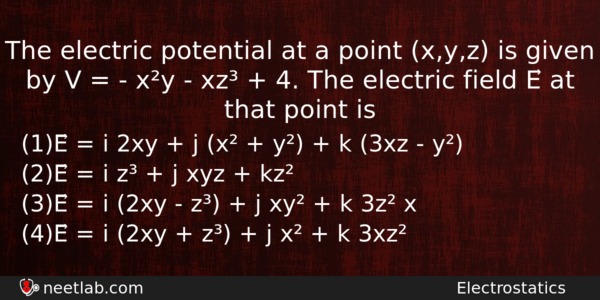| ⇦ | 
| ⇨ |
The electric potential at a point (x,y,z) is given by V = – x²y – xz³ + 4. The electric field E⃗ at that point is
Options
(a) E⃗ = i 2xy + j (x² + y²) + k (3xz – y²)
(b) E⃗ = i z³ + j xyz + kz²
(c) E⃗ = i (2xy – z³) + j xy² + k 3z² x
(d) E⃗ = i (2xy + z³) + j x² + k 3xz²
Correct Answer:
E⃗ = i (2xy + z³) + j x² + k 3xz²
Explanation:
The electric field at a point is equal to negative of potential gradient at that point.
E⃗ = – ?V/ ?r = [ -?V/ ?x i – ?V/ ?y j – ?V/ ?z k ]
E⃗ = i (2xy + z³) + j x² + k 3xz²
Related Questions: - If v is the speed of sound in air, then the shortest length of the closed pipe
- One-fourth length of a spring of force constant K is cut away. The force constant
- Light of wavelength λᴀ and λᴃ falls on two identical metal plates A and B respectively.
- A long straight wire carrying current of 30A is placed in an external uniform
- An electric bulb has a rated power of 50W at 100 V. if it used on an a.c. source
Topics: Electrostatics
(146)
Subject: Physics
(2479)
Important MCQs Based on Medical Entrance Examinations To Improve Your NEET Score
- If v is the speed of sound in air, then the shortest length of the closed pipe
- One-fourth length of a spring of force constant K is cut away. The force constant
- Light of wavelength λᴀ and λᴃ falls on two identical metal plates A and B respectively.
- A long straight wire carrying current of 30A is placed in an external uniform
- An electric bulb has a rated power of 50W at 100 V. if it used on an a.c. source
Topics: Electrostatics (146)
Subject: Physics (2479)
Important MCQs Based on Medical Entrance Examinations To Improve Your NEET Score
18000+ students are using NEETLab to improve their score. What about you?
Solve Previous Year MCQs, Mock Tests, Topicwise Practice Tests, Identify Weak Topics, Formula Flash cards and much more is available in NEETLab Android App to improve your NEET score.
Share this page with your friends

Leave a Reply